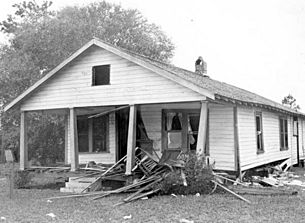Murder of Harry and Harriette Moore facts for kids
Quick facts for kids Murder of Harry and Harriette Moore |
|
|---|---|
| Part of the Civil Rights Movement | |

The home of the Moores after the Christmas Day bombing
|
|
| Location | Mims, Florida |
| Date | December 25, 1951 Evening hours (EST) |
| Target | Harry and Harriette Moore |
|
Attack type
|
Bombing |
| Weapons | Dynamite |
| Deaths | 2 |
| Victims | Harry T. Moore Harriette V. Moore |
| Assailants | Earl J. Brooklyn Tillman H. Belvin Joseph N. Cox Edward L. Spivey |
| Motive | Retribution against Harry Moore for his civil rights activities |
Harry T. Moore and his wife, Harriette V. S. Moore, were brave leaders in the early Civil Rights Movement in the United States. They are remembered as the first people to die for the movement's cause. On Christmas Day, December 25, 1951, a bomb exploded under their bedroom floor in Mims, Florida. They had just celebrated their 25th wedding anniversary. Their deaths marked the first time civil rights activists were killed in this way, and it was the only time a husband and wife were both killed during the movement.
Contents
The Moores' Early Life and Activism
Harry Moore and Harriette Simms got married on December 25, 1926. Harry was a teacher, and Harriette was also a teacher who later became an insurance broker. In 1927, Harry became the principal of the Titusville Colored School. At that time, schools in the U.S. were often separated by race, meaning black and white students went to different schools. Harry taught ninth grade and managed the other teachers. Sometimes, the school would close early, which was part of the unfair treatment against black children.
In 1934, Harry started the National Association for the Advancement of Colored People (NAACP) chapter in Brevard County, Florida. The NAACP is a group that works for equal rights for all people. Harry later became the first leader of the NAACP in Florida. The group worked to get equal pay for equal work for all teachers, no matter their race. They also fought to make sure that violent acts against black people, like lynchings, were investigated. A big part of their work was helping black citizens register to vote.
Harry's work for civil rights was very unpopular with some white people in the area. Because of his activism, Harry and Harriette both lost their teaching jobs in 1946. After that, Harry worked full-time for the NAACP.
The Bombing Event
On the night of December 25, 1951, after celebrating Christmas and their anniversary, the Moores went to their bedroom. Suddenly, a bomb exploded. It was a homemade bomb, likely made from dynamite, placed right under their bedroom floor. Harry and Harriette were badly hurt, but their daughter, who was also home, was safe.
The Moores were quickly taken to the nearest hospital that would treat African Americans in Sanford, Florida, which was about a 30-mile drive. Harry died while being taken to the hospital. Harriette lived for nine more days and passed away after her husband's funeral.
Investigations and Why It Happened
Many people have wondered why the Moores were killed. All investigations have pointed to the same reason: they were attacked because of Harry Moore's work for civil rights.
Since 1951, there have been five different investigations into the bombing. All of them found clues that pointed to four men. These men were high-ranking members of the Ku Klux Klan in central Florida. The Ku Klux Klan is a hate group known for its violence against black people and others.
One of the men, Earl J. Brooklyn, was known for being very violent. He was said to have the floor plans of the Moores' home and was looking for people to help with the bombing. Another man, Tillman H. "Curley" Belvin, was also a violent Klan member and Brooklyn's friend. Joseph Cox was another Klansman. A fourth Klansman, Edward L. Spivey, said that Cox was involved in the bombing. Spivey made this statement in 1978, when he was very sick. Cox died in 1952, one day after the FBI questioned him. Brooklyn and Belvin also died during the first FBI investigation.
The investigations showed that Harry's work for civil rights made him a target for the Klan. Even with all the evidence, no one was ever arrested for the bombing. All four men believed to be involved are now deceased. The federal investigation officially closed in 2011.
Public Reaction to the Tragedy
The morning after the bombing, on December 26, 1951, news spread quickly in the black neighborhoods of Titusville. Soon, people from all over Brevard County, some still in their pajamas, went to Mims to protest. Many knew Harry Moore personally from his teaching, his work with the NAACP, or his voter registration drives.
The Moores' deaths caused protests across the country. Rallies and memorial events were held. President Harry S. Truman and Governor Fuller Warren received many messages protesting the murders. In New York City, on January 5, 1952, baseball star Jackie Robinson held a memorial service that about 3,000 people attended. The NAACP held a large memorial service in March 1952 at Madison Square Garden, with 15,000 people and speakers like the famous poet Langston Hughes.
Langston Hughes wrote a poem about Harry Moore, saying:
And this he says, our Harry Moore
As from the grave he cries
No bomb can kill the dreams I hold
For freedom never dies!"
Honors and Memorials
In 1952, the year after their deaths, Harry Moore was given the Spingarn Medal by the NAACP, a very important award. In 1999, the place where the Moores' home stood in Mims, Florida, became an official Historical Heritage Landmark of Florida. Five years later, Brevard County opened the "Harry T. and Harriette Moore Memorial Park and Interpretive Center" to honor them.
See also

